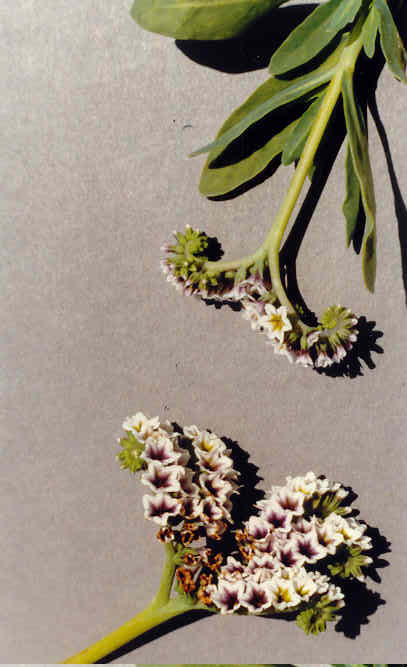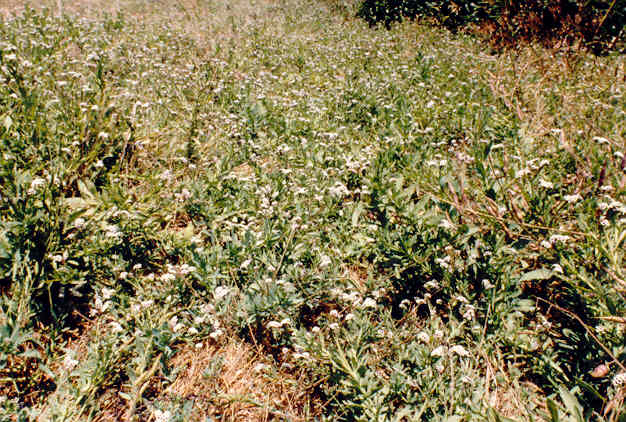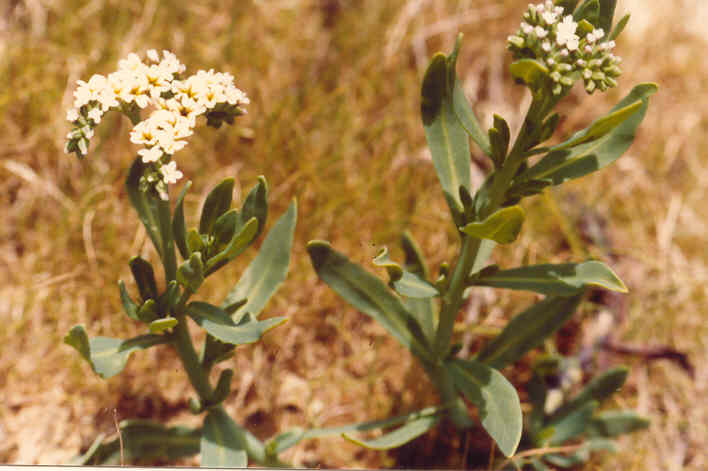
Heliotropium curassavicum L.
=Heliotropium curassavicum var. oculatum
Boraginaceae (Borage Family)
Native
 |
Heliotropium curassavicum L.=Heliotropium curassavicum var. oculatumBoraginaceae (Borage Family)
Native
Salt HeliotropeWild Heliotrope |
June Photo
Plant Characteristics: Perennial with underground rootstocks which send up scattered shoots; stems diffuse, 1-5 dm. long, fleshy, glaucous throughout; lvs. succulent, usually glaucous, oblanceolate to spatulate, cuneate at base, 1-4 cm. long, short-petioled; fls. in dense geminate or solitary scorpioid cymes 2-10 cm. long, sessile, bractless; calyx 2-3 mm. long, 5-toothed or 5-lobed; corolla 3-6 mm. broad, white with yellow spots in throat and usually becoming +/- purple about the center; stamens 5, attached to corolla-tube; fr. glabrous, 1.5-2 mm. broad, subglobose, at last separating into 4 nutlets
Habitat:
Common in saline or alkaline soils, below 7000 ft.; many Plant
Communities; throughout California; to Ariz., Utah. March-Oct.
Name:
Greek, helios, sun, and trope, turning, referring to the summer solstice when the spp. were
supposed to come into fl. (Munz, Flora
So. Calif. 259). Latin, occulus,
eye. (Jaeger 171).
Possibly referring to the flowers. (my
comment). Curassavicum is a place name, coming from Curacao, an island in the
Dutch West Indies. (Dale 74).
General:
Very common in the study area. Photographed on North Star Beach, at 23rd
Street and on the westerly side of the Delhi Ditch.
One of the native halophytes found in Upper Newport Bay. (my comments).
The leaves, which contain a mucilaginous juice, were
dried and made into a powder by the Spanish-Californians, who valued them highly
as a cure for wounds of men and animals. (Parsons 40). The
seeds were used by the Indians for food and a medicine was made from the roots.
(Heizer & Elsasser 246).
A purple dye was made from this plant.
(lecture by Charlotte Clarke, author of Useful
and Edible Plants of California, April 1987.
Delfina Cuero, a Kumeyaay or Southern Diegueno Indian, made the following
comment about Heliotropium curassavicum
in her autobiography: "The roots are boiled for medicinal tea to regulate
menstruation." (Shipek 91). The Tubatulabal Indians of the southern Sierra Nevada
foothills, gathered the seeds of Heliotropium curassavicum by hand and
ate them raw on the spot. (Campbell 164).
About 125 species of warmer regions.
(Munz, Flora So. Calif. 259).
Text Ref:
Dale 78; Hickman, Ed. 381; Munz, Calif.
Flora 554; Munz, Flora So. Calif.
261; Roberts 15.
Photo Ref:
April 7 83 # 21; June 5 83 # 3; June 1 86 # 14,15.
Identity: by R. De Ruff.
First Found: April 1983.
Computer
Ref: Plant Data 205.
Have plant specimen.
Last edit 5/25/05..
 |
 |
June Photo April Photo